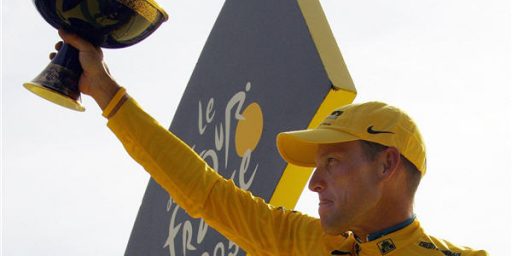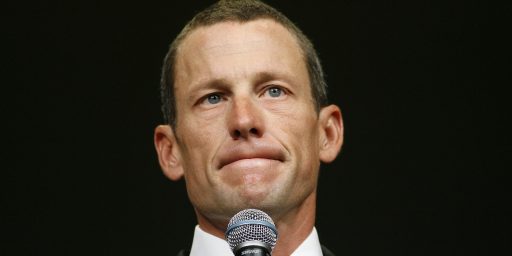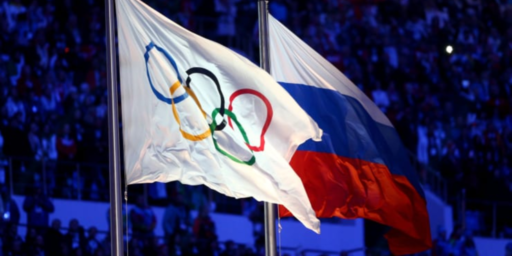Story: Armstrong Tested Positive for EPO Six Times
A French paper published a report Tuesday that cyclist Lance Armstrong tested positive for the performance-enhancing drug EPO six separate times in 1999. Armstrong denies the charges.
USATODAY.com – Story: Armstrong had six positives from 1999 tests (USAT)
One month after winning his seventh consecutive Tour de France and retiring from professional cycling, Lance Armstrong is on the defensive over doping allegations stemming from his first Tour win in 1999. L’Equipe, the leading sports daily newspaper in France, published a report Tuesday that said six different urine samples Armstrong provided during the 1999 Tour tested positive for the performance-enhancing drug EPO when examined in 2004 by a French lab fine-tuning EPO testing. The lab tested all the B samples from the 1999 Tour. EPO, which builds endurance, was a banned substance in 1999 but there was no approved test for it.
Of the 12 samples that returned as positive, six came from Armstrong, the story said. The lab did not identify the samples as being from Armstrong, and the testing was done with assurances that identification of the samples would be confidential and not used for doping enforcement. But L’Equipe reporters matched the samples’ identification numbers in the lab report with information Armstrong released to French judicial investigators in a 2000 doping probe.
Armstrong has been at odds with French doping officials and media since his 1999 win, but he never has been linked to a positive test, a point he emphasized in his prepared rebuttal. “The paper even admits in its own article that the science in question here is faulty and that I have no way to defend myself,” Armstrong said in a statement released late Monday night. “They state: ‘There will therefore be no counter-exam nor regulatory prosecutions, in a strict sense, since defendant’s rights cannot be respected.’ I will simply restate what I have said many times: I have never taken performance-enhancing drugs.”
These are serious allegations, indeed. It’s a shame that we now routinely suspect our best athletes of cheating in this manner and that, as a consequence, such charges result in permanent taint.
I’d like to believe this is not true in Armstrong’s case. Given that he presumably never tested positive for anything that would get him disqualified from a race, he deserves the presumption of innocence here.






I’m inclined to take this as just a witch hunt. The first problem is these were the B-samples, typically if someone tests positive with they run the back up samples to make sure it wasn’t a false positive and in this case there are no ways to confirm the accuracy and precision of the sample results.
I would also be inclined to agree with Miguel Indurain, in wondering why they picked the 1999 samples and who authorized it (one would assume it was the Tour director).
To go along with your presumption, he never tested positive in a test that would of disqualified him (granted there wasn’t a reliable EPO test until 2001). The test could be done anytime because riders are required to report on where they will be everyday of the year. What a life go on vacation, hear a knock at the hotel door and have to pee in a cup.
Plus I think the French are still miffed that their guy Richard Virenque confessed to doping for most of the 90’s in the great Festina scandal, when their health assistant was arrested by customs in 1998 (The Tour of Shame) with illegal quantities of prescription drugs and narcotics. Of course Virenque is still a French hero for winning 7 King of the Mountains.
I heard somewhere that they aren’t even sure the samples are Armstrong’s. I agree that we should assume he’s innocent – after all, had he been using this drug, why didn’t they catch it in later years?
Not Surprising. Actually the French caught Armstrong with three banned substances in his room during the 2005 Tour de France. Soap, toothpaste, and deodorant.
I’m unsure on the dates, but could any of this have been related to Lance’s cancer treatment? I know some cancers produce odd metabolic byproducts.
Another thing to keep in mind L’Equipe really does not like Armstrong. Could they be jumping the gun or even fabricating evidence? Given the recent shoddiness in the MSM I wouldn’t discount it. Still, it looks pretty bad for Armstrong.
There is more at the Tour d’ France blog http://www.tdfblog.com/2005/08/lequipe_story_a.html
He quotes Laurent Fignon, who who states,
“I don’t give a sh**. 1999? This is ancient history. What does this prove and what does this solve?”
“What interests me now is keeping the next generation of cyclists clean and drug-free.”
Strictly speaking the legality of using EPO isn’t the issue, and not just because they can’t prosecute. The crux of the matter is whether he used a substance that gave him an unfair advantage over other cyclists. The pattern of his races–the fact that he won six more times in a row, often by wider margins than in 1999–suggests that he neither needed nor got “extra help” that year.
Compare this, for instance, with Greg Lemond whose performance degraded rather significantly over time. That, ironically, was evidence not of a “helping” but of a “hindering” substance (the lead in his system).